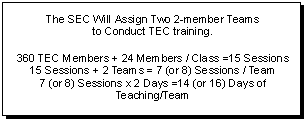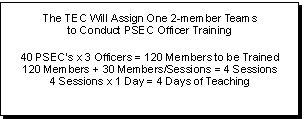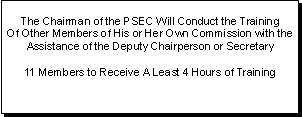
«« Ïðåä. | ÎÃËÀÂËÅÍÈÅ | Ñëåä. »»
V. Putting Some Method Into The Madness!
So far you have outlined your training work plan, decided what you what your training plan will consist of, assigned responsibilities and set deadlines for getting it all done in time for the big event. You have also determined that there are about 14,760 election officials who all need to know what they are doing if the election is going to be carried out smoothly, efficiently and accurately.
Well, it's time we got down to brass tacks. You have to decide what METHOD you will use in executing the plan that, so far, looks so good on paper. Generally speaking, your training method will be defined by the blending of three key ingredients.
THE MODEL ...
THE STYLE ...
AND THE STRATEGY
 A crucial part of that decision is designing the MODEL for the kind of training exercises you intend to carry out to reach the election commission members you have targeted to receive training. In designing the model, there are a number of important questions that need to be answered. A crucial part of that decision is designing the MODEL for the kind of training exercises you intend to carry out to reach the election commission members you have targeted to receive training. In designing the model, there are a number of important questions that need to be answered.
 Will the training be done in person? Will the training be done in person?
 Will the trainers go to the trainees, or will the trainees come to the trainers? Will the trainers go to the trainees, or will the trainees come to the trainers?
 Will every commission member attend formalized training sessions, or will sessions be targeted to only some commissioners, such as chairpersons? Will every commission member attend formalized training sessions, or will sessions be targeted to only some commissioners, such as chairpersons?
 Who will conduct the training exercises? Outside specialists whose only job will be to conduct training? Or, «in-house» manpower whose time will be divided between training and other responsibilities? Who will conduct the training exercises? Outside specialists whose only job will be to conduct training? Or, «in-house» manpower whose time will be divided between training and other responsibilities?
 Will trainers work alone, or will they work in teams? Will trainers work alone, or will they work in teams?
 What is the time frame for carrying out all the training exercises? What is the time frame for carrying out all the training exercises?
 What is the budget for training exercise and who will bear the costs? What is the budget for training exercise and who will bear the costs?
Although there are many variation, there are two models that are the most commonly used in organizing training programs for election officials.
 The Training Corps. In this model a specifically designated corps of trainers are recruited, organized and trained to conduct all the training sessions throughout the jurisdiction. While it is possible to designate a particular group of experienced senior, election commission members to the Training Corps, it is usually very difficult to pull them off of other duties to focus totally on training. In many instances the Training Corps are recruited from the ranks of professional teachers, are hired for a specific period of time, and are paid for their services. They have one job...to train! They are not policy makers or involved in other responsibilities involved in the conduct of the election. Use of a Training Corps is particular productive in the training of commission members such as those at the Polling Station level whose duties are quite specific, procedural in nature and where tasks are somewhat routine. The work intensely for a certain period of time and must usually be prepared to be on the road travelling for at least part of that time since they usually conduct the training on a regional basis visiting groups of commissions at centralized locations. Their work is usually supervised by a senior election official from whom they take direction and to whom they are accountable. The Training Corps. In this model a specifically designated corps of trainers are recruited, organized and trained to conduct all the training sessions throughout the jurisdiction. While it is possible to designate a particular group of experienced senior, election commission members to the Training Corps, it is usually very difficult to pull them off of other duties to focus totally on training. In many instances the Training Corps are recruited from the ranks of professional teachers, are hired for a specific period of time, and are paid for their services. They have one job...to train! They are not policy makers or involved in other responsibilities involved in the conduct of the election. Use of a Training Corps is particular productive in the training of commission members such as those at the Polling Station level whose duties are quite specific, procedural in nature and where tasks are somewhat routine. The work intensely for a certain period of time and must usually be prepared to be on the road travelling for at least part of that time since they usually conduct the training on a regional basis visiting groups of commissions at centralized locations. Their work is usually supervised by a senior election official from whom they take direction and to whom they are accountable.
 The Good News The Good News
Using a Training Corps eases the burden on election commission members by allowing them to concentrate on their other responsibilities. Members of the Training Corp can be recruited specifically for their experience, skills and abilities as good teachers. Because there are generally a smaller number of people involved, there can be greater consistency in the information being imparted, and in the matter in which it is presented
 The Not-So-Good News The Not-So-Good News
Special funding has to be allocated and complex deployment scheduling and logistics arrangements are usually necessary. Extra lead time is usually required for for recruitment and training. Because, they are not members of the commissions themselves, there is little opportunity to develop sustainable working relationships between the trainer and the trainee.
 The Cascade Model. The most common approach to training and one that you have probably used in the past is a Cascade Model. Although it can also be used with a Training Corps, it is particularly suited to training when the trainers will be the commission members themselves. In cascade training, smaller target group of people is trained initially. They, in turn, are responsible to train secondary level of officials. This group will eventially be responsible for training another layer of subordinates. The cascade model is sometimes called the Pyramid Model, because the training is accomplished to an ever growing number of trainees. For example, a configuration of this model would call for the Subject Election Commission to train the Territorial Commissions. Each Territorial Commission would then be responsible to facilitate the training of the Polling Station Election Commissions in their jurisdiction. This method can be very efficient in that a great number of people can be trained in a relatively short period of time The Cascade Model. The most common approach to training and one that you have probably used in the past is a Cascade Model. Although it can also be used with a Training Corps, it is particularly suited to training when the trainers will be the commission members themselves. In cascade training, smaller target group of people is trained initially. They, in turn, are responsible to train secondary level of officials. This group will eventially be responsible for training another layer of subordinates. The cascade model is sometimes called the Pyramid Model, because the training is accomplished to an ever growing number of trainees. For example, a configuration of this model would call for the Subject Election Commission to train the Territorial Commissions. Each Territorial Commission would then be responsible to facilitate the training of the Polling Station Election Commissions in their jurisdiction. This method can be very efficient in that a great number of people can be trained in a relatively short period of time
 The Good News The Good News
No special budgeting is needed. As trainers, commission members may be more in tune with policy issues and political sensitivities which must be considered. They will generally understand the broader picture. Nothing teaches like teaching. This option also allows for building stronger relationships between superior commission members and their subordinate commissions.
 The Not-So-Good News The Not-So-Good News
Not every great commission member is a great instructor. Commission members will have competing demands on their time; Decentralization may result in less consistency in the information being imparted and the manner in which it is being taught. Information may be misinterpreted or misrepresented due to the filter affect of being passed through so many layers.
 The training model selected and the answers to the many questions which brought you to your choice will go a long way in dictating the STYLE of the training exercises that you will be able to carry out. There are a few variations that tend to be the most common. Naturally each variation has advantages and disadvantages. The trick is to weigh them against your overall training objectives, and the ever-present constraints of time, funding, manpower and logistic support which will no doubt impact your choice. Often, training programs can incorporate a combination of styles, however, the variations generally fall into 3 major categories. The training model selected and the answers to the many questions which brought you to your choice will go a long way in dictating the STYLE of the training exercises that you will be able to carry out. There are a few variations that tend to be the most common. Naturally each variation has advantages and disadvantages. The trick is to weigh them against your overall training objectives, and the ever-present constraints of time, funding, manpower and logistic support which will no doubt impact your choice. Often, training programs can incorporate a combination of styles, however, the variations generally fall into 3 major categories.
 Large Audience Sessions. These training sessions usually involve classes of 100 or more trainees all of whom are to be trained in the same procedures. Usually this training style involves a lecture format, although it is possible to integrate some audio/visual materials and handouts. Because so many people are involved at one time it is usually scheduled around a single session in which the entire training program is taught at once. This type of training is conducted in large, auditorium type settings. In general, the trainees are brought to the trainers at a centralized location, although in very large territories, several regional locations can be established as sites for large groups in the same region Large Audience Sessions. These training sessions usually involve classes of 100 or more trainees all of whom are to be trained in the same procedures. Usually this training style involves a lecture format, although it is possible to integrate some audio/visual materials and handouts. Because so many people are involved at one time it is usually scheduled around a single session in which the entire training program is taught at once. This type of training is conducted in large, auditorium type settings. In general, the trainees are brought to the trainers at a centralized location, although in very large territories, several regional locations can be established as sites for large groups in the same region
 The Good News The Good News
More people can be trained at one time with fewer teachers. Centralized oversight are simpler in finding appropriate space
 The Not-So-Good News The Not-So-Good News
This style of training does generally allow interactive participation. It can tend to be boring since people have to sit and listen for a longer period of time.
 Medium Size Group Sessions, This style of training accommodates smaller groups of trainees who are brought together for a single training event, or for a series of workshops. These sessions usually bring together more than 50, but fewer than 100 trainees. This; approach is suitable for a workshop style training that can be facilitated in conference room type accommodations and allows trainers some flexibility in how they conduct their program. For example, the audience can be divided into smaller groups for certain creative exercises designed to lend interest to the program or to emphasize certain aspects of the training. Medium size group sessions can also allow a combination of lecture formats for the entire group all at once, with rotating break out sessions where the trainees are divided into smaller groups for sections of the program dealing with separate components of the program. The groups then rotate so that by the end of the workshop, all trainees have participated in each of the separate break out sessions. Medium Size Group Sessions, This style of training accommodates smaller groups of trainees who are brought together for a single training event, or for a series of workshops. These sessions usually bring together more than 50, but fewer than 100 trainees. This; approach is suitable for a workshop style training that can be facilitated in conference room type accommodations and allows trainers some flexibility in how they conduct their program. For example, the audience can be divided into smaller groups for certain creative exercises designed to lend interest to the program or to emphasize certain aspects of the training. Medium size group sessions can also allow a combination of lecture formats for the entire group all at once, with rotating break out sessions where the trainees are divided into smaller groups for sections of the program dealing with separate components of the program. The groups then rotate so that by the end of the workshop, all trainees have participated in each of the separate break out sessions.
 The Good News The Good News
The work shop style generates more interest, and avoids restlessness among trainees which often occurs during lengthy lectures. It also provides opportunity for interaction between trainers and trainees that can help trainers know where there are misunderstandings.
 The Not-So-Good News The Not-So-Good News
Work shop style training requires more elaborate logistics, and time for preparation. It usually involves more instructors, and certainly a greater number of separate sessions. Work shops also demand more creativity in planning and preparation
 Small Interactive Classes. This style of training involves groups of no more than 40 trainees, and preferably about 20-25. In the context of training polling station election commissions, for example, the small interactive classes are suited to a decentralized training plan where commission members are trained closed to home. Surveys and tests show that interactive classes are generally more appealing and effective. They also allow much greater flexibility as to the amount of innovation which can be introduced into the training program. They are ideally suited for a training style that relies less on lecturing and more interactive participation through question and answer periods, demonstrations, role playing, quiz and other interactive exercises. Small Interactive Classes. This style of training involves groups of no more than 40 trainees, and preferably about 20-25. In the context of training polling station election commissions, for example, the small interactive classes are suited to a decentralized training plan where commission members are trained closed to home. Surveys and tests show that interactive classes are generally more appealing and effective. They also allow much greater flexibility as to the amount of innovation which can be introduced into the training program. They are ideally suited for a training style that relies less on lecturing and more interactive participation through question and answer periods, demonstrations, role playing, quiz and other interactive exercises.
 The Good News The Good News
They can be more flexible in terms of scheduling at convenient times for trainees without disrupting their normal daily activities. Classes can be held in almost any room or space. More information can generally be covered in less time per session. Interactive classes result in better learning. Small classes are perfectly suited to use of «in-house» manpower where senior officials train their own subordinates. Depending on deployment, it is possible for a large number of people to be trained in a relatively short period of time.
 The Not-So-Good News The Not-So-Good News
If training specialists are being used, you'll need more of them. You can still use a lecture format, but if the benefits of interactive training are to be realized, trainers will require additional preparation in organizing and facilitating innovative training styles. Creative materials and supplies may be needed. Additional logistic support is needed regarding scheduling, accommodations and distribution of training materials to numerous sites.
 No matter what style of training you choose for your program, it will be totally reliant on the effectiveness of the STRATEGY you employ for carrying it out. And, style and strategy are irrevocably interlinked. Designing a workable strategy requires you to quantify your objectives based on a few pre-determined assumptions. No matter what style of training you choose for your program, it will be totally reliant on the effectiveness of the STRATEGY you employ for carrying it out. And, style and strategy are irrevocably interlinked. Designing a workable strategy requires you to quantify your objectives based on a few pre-determined assumptions.
Now, it is may not be as earth shattering as E=MC , but you will probably have to break down and do some basic mathematical number crunching just to see what you are up against. At the very least you will need to know how many trainers it will take, at how many training sessions to train the number officials you want to receive training. And, here is where you will factor a few other details based on the some of the answers or assumptions you arrived at when you were contemplating the kind of model you would pursue in your training plan.
For the sake of this discussion, we will rely on our description of a typical Subject which we said was made up of 30 Territorial Commissions each of whom supervised 40 Polling Station Election Commissions. And, each commission had 12 members. Based on that assumption we concluded that there would be:
 360 Territorial Commission members to be trained; and 360 Territorial Commission members to be trained; and
 14,400 Polling Station Commission members to be trained. 14,400 Polling Station Commission members to be trained.
After you have reviewed your options, you have tremendous flexibility in determining what assumptions will serve as the basis for your implementation strategy. For the purpose of this discussion let's pose one combination so that we can see how your assumptions will impact your overall strategic plan.
 You have selected the Cascade Model for your training exercises and intend to utilizing commission members as trainers. You have selected the Cascade Model for your training exercises and intend to utilizing commission members as trainers.
 You want to use a Small Interactive Class style for your training with no more than 30 participants in any given class. You want to use a Small Interactive Class style for your training with no more than 30 participants in any given class.
 You believe that training will be more effective if sessions are conducted by teams of two instructors. You believe that training will be more effective if sessions are conducted by teams of two instructors.
 In your cascade, you have decided that all 360 Territorial Commission members will attend training sessions which conducted by selected members of the Subject Election Commission Quick Start Guide to Better Training In your cascade, you have decided that all 360 Territorial Commission members will attend training sessions which conducted by selected members of the Subject Election Commission Quick Start Guide to Better Training
You have also decided that Territorial Commissions will organize training classes for the Chairpersons, Deputy Chairpersons, and Secretaries of the Polling Station Election Commissions in their jurisdictions. The Chairpersons of the Territorial Commissions will be responsible to select whom they want to assign training responsibilities.
Finally, you have decided that Chairmen of Polling Station Election Commissions will be responsible to conduct the training sessions for the members of their own commission.
 Members of the same commission will be attend the same training sessions so they all receive the same information, in the same manner, at the same time. Members of the same commission will be attend the same training sessions so they all receive the same information, in the same manner, at the same time.
 Territorial Commission members will require a two day session of training that will be conducted on consecutive days. Territorial Commission members will require a two day session of training that will be conducted on consecutive days.
 Officers of the Polling Station Commissions who will be attending training sessions conducted by the Territorial Commission will require one full day of training. Officers of the Polling Station Commissions who will be attending training sessions conducted by the Territorial Commission will require one full day of training.
 Other member of the Polling Station Commissions will need approximately 1/2 day of training to be conducted within the week immediately prior to the election. Other member of the Polling Station Commissions will need approximately 1/2 day of training to be conducted within the week immediately prior to the election.
Armed with these educated assumptions, you now have the basis for quantifying some of the details of your overall strategy.



 Congratulations! The Good News is that 14,760 commission members can be trained in a total of 21 Training Days. Congratulations! The Good News is that 14,760 commission members can be trained in a total of 21 Training Days.
!!! A «DOUBLE DUTY» EXTRA
With all the time and energy you are putting into organizing a comprehensive training program for your commission members at all levels, it would be a shame not to capitalize on opportunities to share .some of that training with the other audiences you know need to be better informed.: So let :your training exercises do Double Duty!
- Make sure deliberative voting members sit in on at least one training Session. Make sure they get copies of any training materials you distribute for training purposes. Encourage them to share the information with their candidates and nominating organizations.
- Ask nominating organizations if they are intending to organize observer teams to be present at polling coordinating observers to attend a training session Encourage them to use what they have learned to prepare their observers to understand what they observe on election day
- Invite representatives of the media to work with you in preparing a video of portions of the training that relate specifically to how voters will be processed on election day This is an ideal time to utilize demonstration and proper planning and rehearsal, they might be able to air the tape on televisions. That means you will have also created a training opportunity for voters, too
«« Ïðåä. | ÎÃËÀÂËÅÍÈÅ | Ñëåä. »»

| 